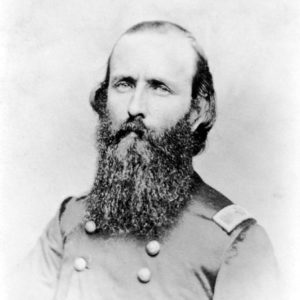calsfoundation@cals.org
Operations around Fayetteville (October 25–November 4, 1864)
| Location: | Washington County |
| Campaign: | None |
| Dates: | October 25–November 4, 1864 |
| Principal Commanders: | Colonel Marcus LaRue Harrison (US); William “Buck” Brown and Colonel William H. Brooks (CS) |
| Forces Engaged: | First Arkansas Cavalry (US); Guerrilla units assembled as Brooks’s cavalry |
| Estimated Casualties: | 9 wounded (US); 75 killed or wounded, 25 captured (CS) |
| Result: | Continued Union control of Fayetteville |
Fayetteville (Washington County) was under Union control from September 1863 to the end of the Civil War. The First Arkansas Cavalry under the command of Colonel Marcus LaRue Harrison was stationed at Fayetteville with orders to patrol and establish order in northwestern Arkansas. The area the troops oversaw covered several counties from the Missouri line to the Arkansas River. Troops kept communications open by maintaining the telegraph line (which was frequently cut) from Van Buren (Crawford County) to Cassville, Missouri. They also escorted supply, subsistence, and mail trains between Cassville, Fayetteville, and Van Buren, and tried to keep the area free of Confederate troops and roaming guerrilla bands. The problems with guerrilla bands occupied much of their time, as the bands frequently threatened the supply and mail trains, as well as foraging parties.
On October 20, 1864, Col. Harrison, who was escorting a supply train from Cassville, routed one Confederate force and avoided another before arriving at Fayetteville on October 25. Almost immediately, the Rebel forces under William “Buck” Brown and Col. William H. Brooks began a siege of Fayetteville. Brown was a notorious guerrilla leader from northwestern Arkansas who commanded about 500 men at the time. Brooks had orders to collect all the predatory guerrilla bands of northwestern Arkansas and enlist them into the Confederate army to form a cavalry brigade of nearly 1,200.
Fortifications had been started around Fayetteville in the spring of 1863, and Harrison’s troops continued to work on them. He thought that by reducing rations of bread to seven ounces a day for each soldier, he could withstand a siege of twenty days. Obtaining forage was his biggest challenge, and although he could not send out a train, he sent out small parties of men when he could. Captain Hugo C. C. Botefuhr, First Arkansas Cavalry, was in charge of the fortifications and worked day and several nights by torchlight to keep fortifications is order.
On October 27, Captain Dewitt C. Hopkins, along with a foraging detachment, was attacked by 500 men under Brown. Hopkins fell back five miles to Fayetteville without loss. He narrowly escaped capture from 800 troops under Brooks who came to Brown’s assistance. On October 28 at sunrise, Brooks’s troops occupied East Mountain and began an attack on the outworks of Fayetteville. Harrison ordered Hopkins and Captain Ezra B. Harrison with a dismounted force to charge Brooks’s troops on East Mountain. On the third attempt, the Union troops captured the summit and drove the Confederates from the mountain. While the Union forces advanced up the mountain, Harrison commenced shelling Brooks’s troops with a twelve-pounder mountain howitzer, causing the Confederate troops to change position several times. Twelve Rebels were found dead and were buried by the Union troops. Union losses at this point included seven wounded.
At 10:00 a.m. on October 28, Brown attacked the west side of Fayetteville but was repulsed. The whole engagement lasted until about noon, when the Confederates retreated. Eleven Rebels were killed or wounded. Harrison reported that the men who drove the Confederates from East Mountain performed gallant service and mentioned by name Captain George R. King, Lieutenant John Vaughan, and Lieutenant Warren W. Munday. In the days following, Brown and Brooks remained around Fayetteville and cut off communications and supplies. Harrison thought they were waiting for assistance from Major General Sterling Price on his return from Missouri.
On November 3, a scout came into town and reported that Gen. Price had dispatched General James F. Fagan from Cane Hill (Washington County) with 8,000 men and two pieces of artillery to march upon the town. The report was nearly correct, with Gen. Fagan having 5,200 men with him, and he was joined by 1,500 men under Brown and Brooks. Fagan attacked the Union pickets and began shelling the town without giving townspeople time to remove families or surrender. They bombarded the town with one six-pounder rifled gun and one twelve-pounder field howitzer until sundown. The Confederates charged three times, but when coming in range of the Union rifles, they fled to a safe location. At sunset, Fagan started retreating with his artillery by various routes toward Cane Hill. At sunrise on November 4, only about 600 remained to cover the retreat. They soon left, ending the present siege of Fayetteville.
No reports were filed by the Confederate leaders, but Confederate prisoners reported that twenty-five were captured and seventy-five were killed or wounded. Union losses totaled nine wounded. Union strength during the siege was 958 volunteers in the First Arkansas Cavalry and 170 militia.
For additional information:
Britton, Wiley. The Civil War of the Border, Vol. 2. New York: G. P. Putman’s Sons, 1899.
Mahan, Russell L. Fayetteville, Arkansas, in the Civil War. Bountiful, UT: Historical Byways, 2003.
Sutherland, Daniel E., ed. Guerrillas, Unionists, and Violence on the Confederate Home Front. Fayetteville: University of Arkansas Press, 1999.
The War of the Rebellion: A Compilation of the Official Records of the Union and Confederate Armies. Series I, Park 1, Vol. 41. Washington DC: Government Printing Office, 1893.
Carolyn Yancey Kent
Jacksonville, Arkansas
 Civil War through Reconstruction, 1861 through 1874
Civil War through Reconstruction, 1861 through 1874 Military
Military ACWSC Logo
ACWSC Logo  M. LaRue Harrison
M. LaRue Harrison 



Comments
No comments on this entry yet.